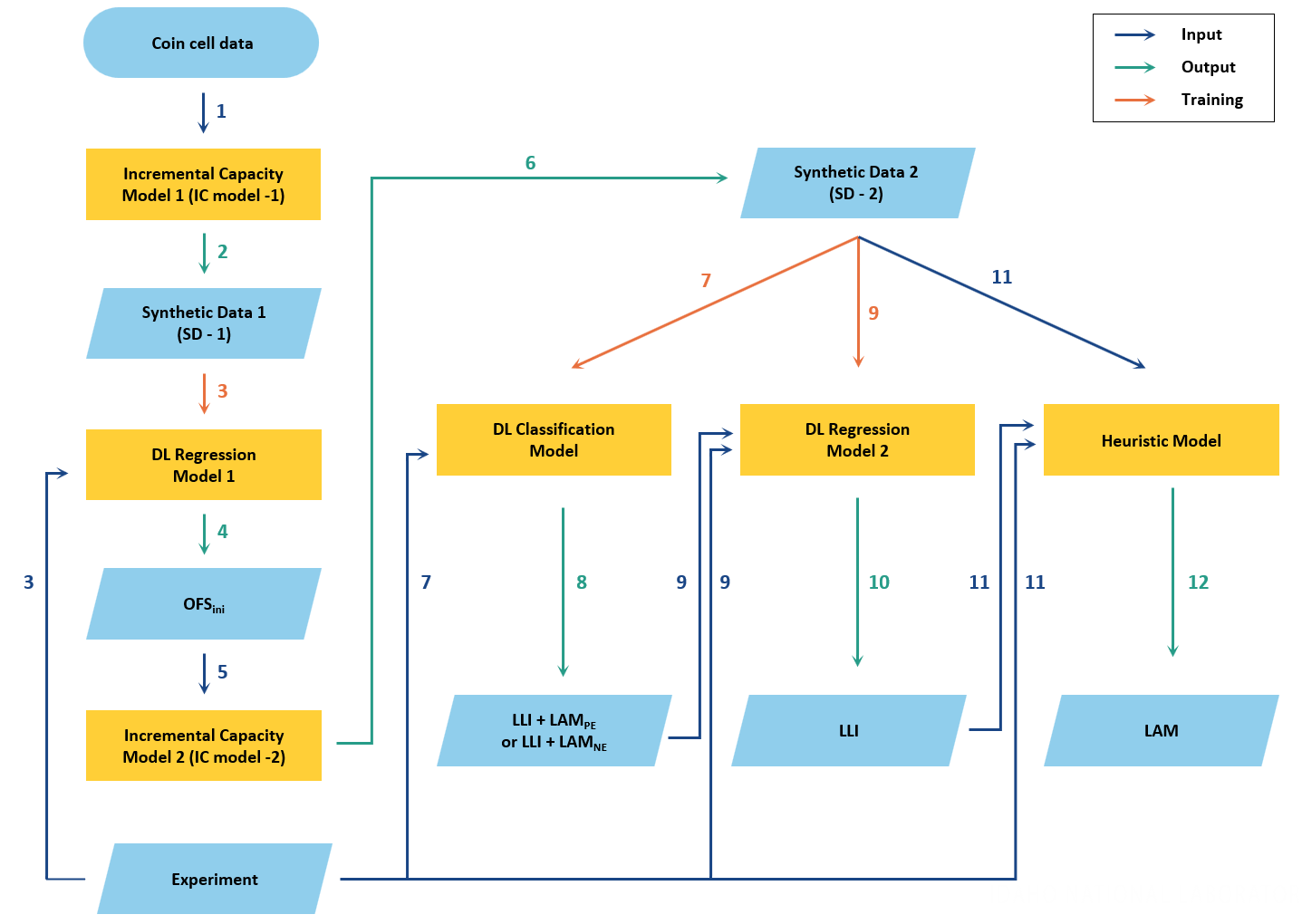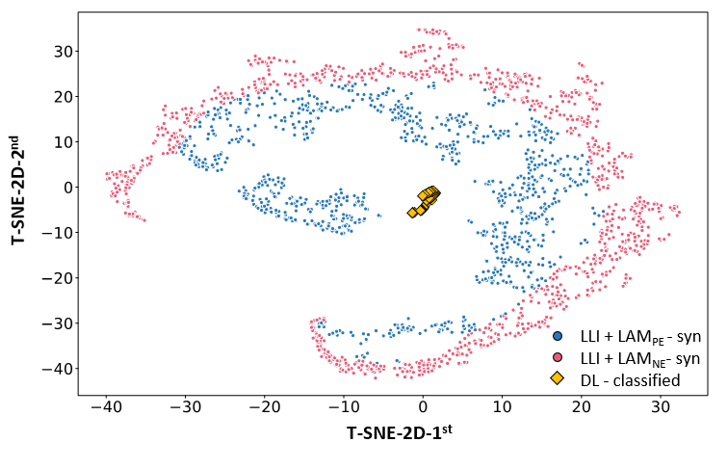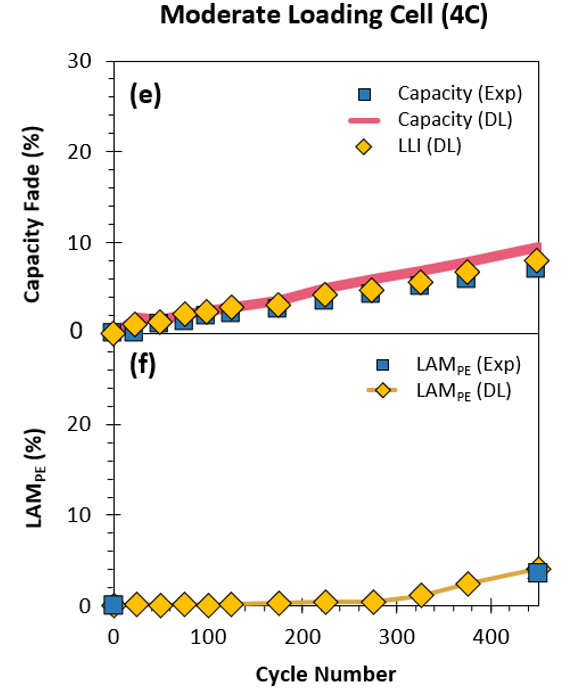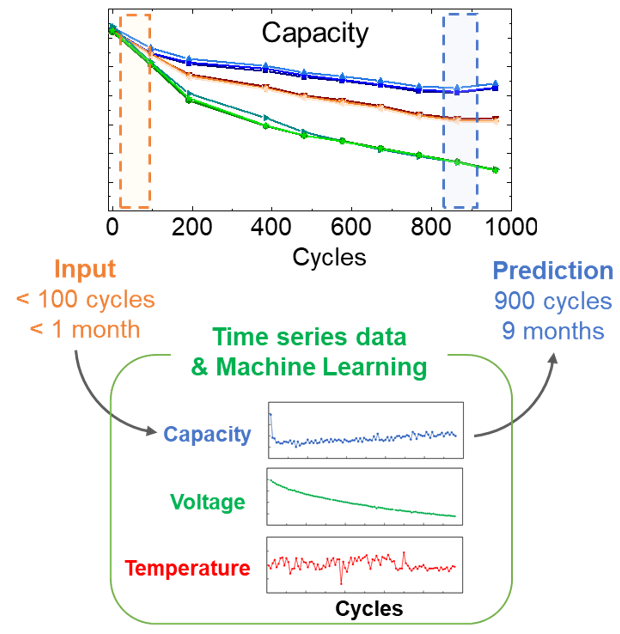The development and deployment of batteries in new, diverse applications requires that the batteries function in the necessary environment. This requires a deep understanding of battery performance, life, and expected failure mechanisms. In the past, the primary means to advance knowledge on performance and life was to test batteries for extended periods of time under a range of different scenarios. This testing of batteries can take more than a year just to make reasonable estimations of life and clearly identify failure modes and rates. The need to shorten the design and testing cycle is critical to bringing new battery chemistries and cell designs into emerging applications such as in stationary energy storage to support EV-charging stations capable of XFC and to meet the demands of a changing mobility landscape. A combination of
physics-based life models and machine learning (ML) provides the opportunity to enable more-robust assessment of battery aging, failure-mechanism identification, and understanding as new use-case scenarios are proposed. The current program sponsored by DOE is focused on means to apply ML to enhance the estimation of life while also identifying key failure pathways. INL researchers look at early life-cycle data (experimental or synthetic), identity key electrochemical signatures regarding different dominant aging modes, and then classify them in an ML framework for identifying key changes happening within component levels in a battery for a particular application. This step is crucial for providing feedback on battery early design revision and/or optimization. The advanced prognostics capability on battery life and performance along with the underlying dominating aging modes, which are typically path dependent, are achieved by using and combining multiple modeling toolsets—e.g., quantitative incremental-capacity-based deep learning, CellSage-Kinetic & Transient Analyses (KTA) (https://www.youtube.com/watch?v=V4P93KrEL1o), reduced-order modeling, and the National Renewable Energy Laboratory's (NREL's) life modeling—all in an automatic ML framework.
Rapid Failure Mode Classification and Quantification in Batteries: A Deep Learning Modeling Framework

A flowchart showing the procedures using the DL framework for identifying initial cell conditions, classifying dominating aging modes, and quantifying them


Classification of dominant aging modes using Deep Learning
| Quantification of cell aging and underlying modes using Deep Learning
|
Unique, rapid identification and quantification of the dominant aging modes in lithium-ion batteries (LiBs) with early and non-specialized test data is a significant scientific challenge. Leveraging synthetic-data, deep-learning (DL) techniques have great potential to enable fast and robust classification and quantification of battery aging modes that produce different patterns of cell aging. This Rapid Failure Mode Classification and Quantification in Batteries: A Deep Learning Modeling Framework study presents, for the first time, a synthetic–data-based DL modeling framework for rapid and automatic classification and quantification of battery-aging modes and resultant aging, with experimental validation of the technique. This automatic classification and quantification provide significant benefit over conventional aging-mode identification and quantification analysis which is manual and requires substantial time, effort, and experimentation. The proposed framework will help advance rapid LiB technology validation, early design improvement, and reliable diagnostic and prognostic methods.
Hierarchal machine learning for early battery performance prediction

A key step limiting how fast batteries can be deployed is the time necessary to provide evaluation and validation of performance. Using data analysis approaches, such as machine learning, we can speed the validation process up. Kunz et al. in a latest
article showed the ability to predict battery performance after 9 months by using only 5% of the total test data that include real-life electric vehicle usage profiles. While error is low across the projections, this study highlights that battery lifetime analysis using only cycling data may not extrapolate safely to certain real-world conditions because of the impact of calendar degradation.
A Machine Learning framework that classifies key cell aging phenomena

Chen et al. established a machine learning (ML)
framework that classifies key cell aging phenomena- normal SEI growth and Li plating for fast charging Li-ion batteries, as an example case study. The ML-based framework identifies and combines key electrochemical (EC) signatures that are physically related to normal SEI growth or Li plating, then classify them with early cycling data. Such early detection of Li-plating using global EC signatures could reduce battery design and maturation lifecycle and improve safety.
Publications
Research Contact: Tanvir Tanim - Phone: (208) 526-5713 - Tanvir.Tanim@inl.gov
Eric Dufek - Phone: (208) 526-2132 - Eric.Dufek@inl.gov

